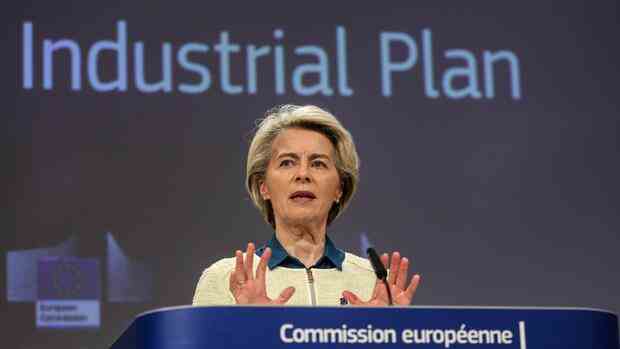The head of the Commission wants to keep companies with tax rebates in the EU.
(Photo: Bloomberg)
Berlin, Brussels The EU Commission wants to provide the member states with 350 billion euros for green investments in the short term in order to react to the American Inflation Reduction Act (IRA). The EU state aid rules are to be relaxed in such a way that the 27 governments can also pay out these funds to companies in the form of tax breaks.
The 350 billion euros would soon be available as a “bridging solution”, said Commission President Ursula von der Leyen (CDU) at the presentation of the green industrial plan on Wednesday in Brussels. “I hope Member States will use this money.”
The sum consists of up to 250 billion euros from the Repower EU fund and 100 billion euros from the cohesion fund. The Repower EU fund consists primarily of unused corona loans. These are now being repurposed to support the “net-zero industry” (wind power, solar cells, batteries, electric cars and hydrogen).
The Cohesion Fund is one of the largest items in the regular EU budget. The funds are traditionally there to even out the economic differences between the EU countries. The 100 billion were already earmarked for the green transformation of the economy. They are now to be used in an even more targeted manner for specific sectors.
Federal Minister of Economics Robert Habeck (Greens) praised the plan as a “good basis” for the discussion in the coming weeks. The proposal sets the right priorities and fits in with what the federal government is doing. “Above all, we need faster processes and better ways to promote the green technologies of the future,” said the minister.
Subsidy race between the EU and the USA has begun
With its proposal, the EU Commission is reacting to the US $369 billion subsidy program. In the coming years, it will be decided where the “net zero industry” will settle, said von der Leyen.
Some funds are now being reallocated to support key green industries such as wind power, solar cells, batteries, electric cars and hydrogen.
(Photo: dpa)
The EU is in a good starting position in the race because three years ago it declared the green conversion to be a growth strategy. In view of new subsidies in the USA, China and Japan, one must now ensure that one can keep up with global competition.
The proposal is intended to form the basis for discussion at the special summit of EU heads of government on February 9th. The Commission then wants to draw up a legal text that is to be approved by the heads of government in mid-March. After that, the new rules would apply.
>> Read here: The EU must not stand still in the subsidy race
Von der Leyen emphasized that the wishes of the companies had been listened to. They cited the US tax rebates as a major incentive to invest in the US. “It is important that we can now say that we have the same opportunities here,” said the head of the commission.
Specifically, according to Competition Commissioner Margrethe Vestager, if a company in the US is offered $1 billion to move production there, an EU country can now spend the same amount to persuade the company to stay. Apparently, the EU is entering a subsidy race after all – which it has always dismissed out of hand.
>> Read here: Dispute – How much Industrial policy must be?
Business associations reacted cautiously to the Commission’s proposal. So far, the contours are still too blurred, said the President of the German Chamber of Industry and Commerce (DIHK), Peter Adrian. “Whether the program really sets a new agenda for competitiveness or just continues previous programs under a new name remains to be seen.”
Commission also wants a “sovereignty fund”
In the longer term, the Commission also wants to set up a “sovereignty fund” for green investments. One needs common European financing for strategically important sectors, explained von der Leyen.
However, the fund would still take some time because you first have to talk to the member states about the financing instruments. Several member states, including Germany, reject new joint debt. The Commission is therefore restricting itself to reallocating existing funds for the time being.
The plan was met with skepticism in the European Parliament. Green MEP Henrike Hahn said the Commission’s proposal was primarily “a list of minor improvements to existing EU instruments”.
>> Read here: Response to “Inflation Reduction Act” – Is the EU threatened with fragmentation?
The CSU MEP Markus Ferber spoke of “sleight of hand”. The Commission moves funds from A to B and gives them new headings. “More money is not available, however,” he said. However, Ferber is also against setting up a new debt fund.
More: What EU funds are there – and how much does the EU still have in reserve?
